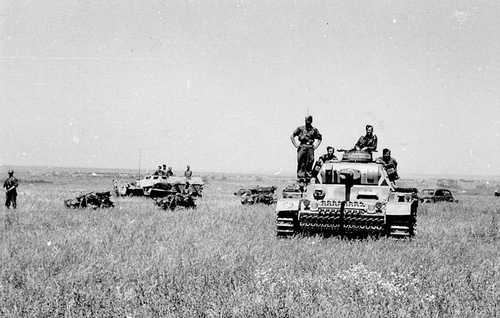
German Armored Forces & Vehicles
"Wiking" in the Caucasus, 1942.
US Federal Archive/Bundesarchiv.
PzKpfw III Ausf E of SS Panzer Regiment 5, "Wiking", and other vehicles of 5th SS Division, "Wiking", advancing on Maikop, Caucasus region, as part of the southern element of "Operation Blue", the German Summer Offensive of 1942. The original orientation of "Blue" was towards the capture of the Caucasus region between the Black Sea and the Sea of Azov, an area containing valuable agricultural and mineral resources and, above, all, oil. The north Caucasus oilfields supplied some 10 per cent of the Soviet Union's oil production at the time; the southern fields, centred on Baku and Grozny, an additional 80 per cent. The northern flank of this main effort was to be protected by a covering German thrust towards the Volga - and Stalingrad. "Blue" was a high-risk operation. It posed the Germans substantial and complex logistical and supply problems, and ultimately only made sense in terms of the Germans' over-confident assumption that the Soviet Red Army was incapable of launching a major and decisive counter-offensive. Early phases of the offensive were very successful - although the initial German assumption of a high yield of Soviet prisoners was not realized, in large part due to the (initially) headlong and disorganized Soviet retreat. This encouraged Hitler to redistribute his forces towards the northern thrust; by the time stiffening resistance in the Caucasus persuaded him to reverse this, the Germans had expended considerable resources in moving forces and materiel first in one direction, then in the other, for no advantage whatsoever. While Maikop was, briefly, captured, the major objectives of Grozny and Baku eluded the Germans in view of stiffening Soviet resistance. Meanwhile, the position to the north, in the flank-protecting thrust, went critical, as the Soviets exploited the gap that had opened up between the northern and southern elements of "Blue" to launch a pincer movement, cutting off the German 6th Army at Stalingrad. The collapse of the 6th Army forced a German retreat in the north, in turn forcing the relatively successful German forces in the Caucasus to withdraw in the face of probable isolation. "Operation Blue" was, pretty well, a total failure from a German viewpoint, being productive only of huge casualties and loss of materiel on both sides. Best regards. JR.
4061 Views
3/3/2015
